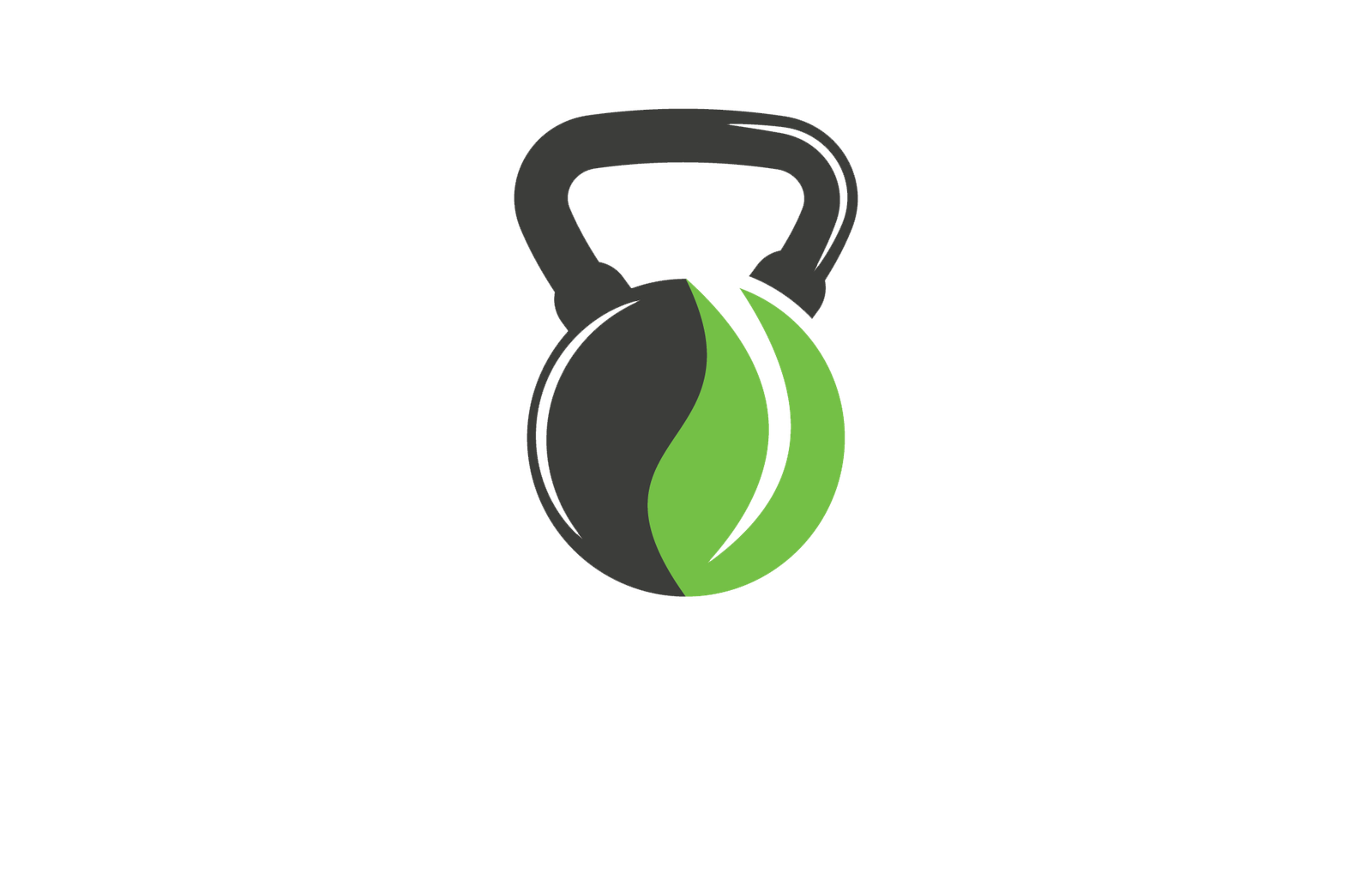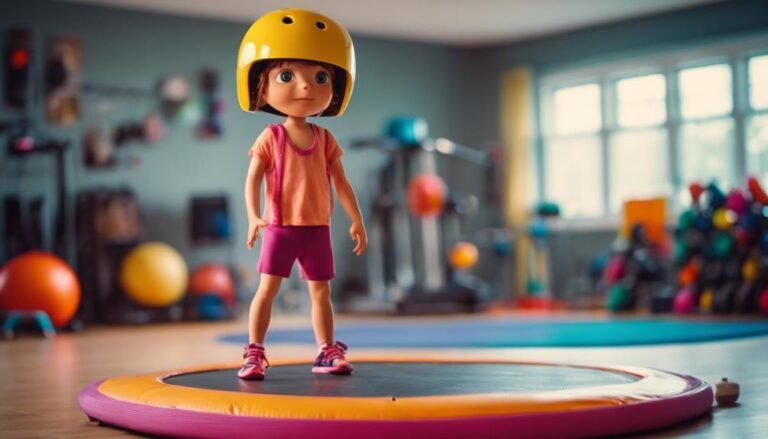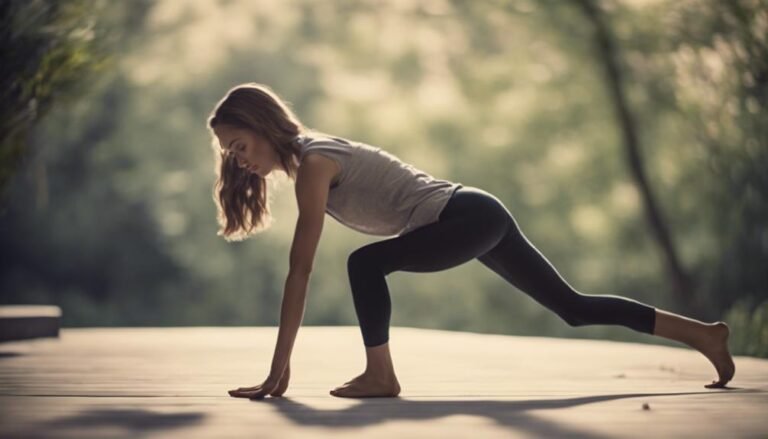Don't miss our holiday offer - 20% OFF!
Core-Focused HIIT Workouts for a Stronger Midsection
Pump up your fitness journey with a core-focused HIIT workout that will transform your midsection and leave you craving more.
We're building a stronger, leaner, and more resilient body by harnessing the power of core-focused HIIT workouts that target the deep core muscles, resulting in improved posture, enhanced athleticism, and a reduced risk of back pain. By engaging our core stability and mastering exercises like planks, Russian twists, and leg raises, we're activating a stronger midsection that boosts our overall fitness and athleticism. With the right techniques and progressive overload, we can sculpt a rock-solid core that takes our workouts to the next level. Now, let's dive deeper into the ultimate core-focused HIIT workout routine that will transform our bodies forever.
Key Takeaways
- Core stability is rooted in the pelvic floor, engaging it increases core stability, allowing for more power and precision in movements.
- A strong core foundation is essential for intense workouts and daily activities, focusing on exercises that target deep core muscles builds a foundation for overall fitness.
- Core-focused HIIT workouts improve posture, enhance athleticism, prevent injuries, increase energy, and lead to a stronger, leaner, and more resilient body.
- Effective core exercises include plank exercises, Russian twists, and leg raises, which target the transverse abdominis muscle, obliques, and lower abs.
- Incorporating a mix of exercises, gradual progressive overload, and mindful breathing helps maintain a stable core throughout the workout, targeting the right muscles and avoiding imbalances.
Building a Stronger Core Foundation
As we venture on this core-focused HIIT journey, we must first lay the groundwork by building a stronger core foundation, one that will serve as the stabilizing force behind our most intense workouts. We're not just talking about visible abs, but a robust core that provides the stability and power we need to take our fitness to the next level. A strong core foundation is built on core stability, which is the ability of our core muscles to maintain proper posture, control movement, and generate force. This stability is rooted in our pelvic floor, the group of muscles that spans the bottom of our pelvis. When our pelvic floor is engaged, our core stability increases, allowing us to move with more power and precision. By focusing on exercises that target our deep core muscles, we'll build a foundation that will support us throughout our HIIT journey. With a strong core foundation, we'll be able to tackle even the most challenging workouts with confidence and precision.
Benefits of Core-Focused HIIT Workouts
By incorporating core-focused HIIT workouts into our fitness routine, we can tap into a multitude of benefits that will revolutionize our overall fitness journey. One of the most significant advantages is improved posture. A strong core provides a solid foundation for our entire body, allowing us to stand taller and more confidently. This, in turn, can boost our self-esteem and overall sense of well-being. Additionally, core-focused HIIT workouts can enhance our athleticism. By strengthening our core, we can improve our power, speed, and agility, making us more effective in our chosen sports or activities. We'll be able to perform daily tasks with more energy and efficiency, and tackle physical challenges with confidence. In addition, a strong core can help prevent injuries and reduce our risk of back pain. By committing to regular core-focused HIIT workouts, we'll be amazed at how quickly our bodies adapt and respond, leading to a stronger, leaner, and more resilient us.
Effective Core Exercises for HIIT
Our core-focused HIIT workouts wouldn't be complete without incorporating exercises that specifically target our core muscles, and we're about to explore the most effective ones to get us started. A strong core is essential for overall athletic performance, and we can't achieve that without exercises that challenge our core stability. When we neglect our core, we risk developing muscle imbalances that can lead to injuries and poor performance.
Here are three effective core exercises to add to our HIIT workouts:
- Plank: This isometric exercise targets our transverse abdominis muscle, which is essential for core stability.
- Russian twists: This exercise targets our obliques, which are vital for rotational power and overall core strength.
- Leg raises: This exercise targets our lower abs, which are often neglected in traditional core workouts.
Incorporating these exercises into our HIIT workouts will not only improve our core stability but also enhance our overall athletic performance. By targeting our core muscles, we'll be able to generate more power, speed, and agility in our workouts.
Sample Core HIIT Workout Routine
Now that we've covered the essential core exercises, let's put them into action with a sample core HIIT workout routine that will challenge our core stability and boost our athletic performance. This routine is designed to debunk the myths surrounding core training, as outlined in our Core Mythbusters series. We'll be incorporating a mix of exercises that target our entire core, including our abs, obliques, and lower back.
Here's a sample workout routine:
Warm-up: 5-minute dynamic warm-up, including leg swings and arm circles
Circuit 1: Plank jacks (30 seconds), Russian twists (30 seconds), rest (30 seconds)
Circuit 2: Mountain climbers (30 seconds), bicycle crunches (30 seconds), rest (30 seconds)
Circuit 3: Flutter kicks (30 seconds), side plank (each side, 30 seconds), rest (30 seconds)
Cool-down: 5-minute stretching routine, focusing on our core and legs
To make this workout even more engaging, we recommend creating a Workout Playlist that pumps us up and keeps us motivated throughout the routine. With this sample core HIIT workout routine, we'll be on our way to a stronger, more stable core in no time!
Progressive Overload for Core Gains
We're about to take our core gains to the next level by pushing our limits with progressive overload, a training method that's proven to spark significant improvements in core strength and endurance. This approach helps us break through the dreaded core plateau, where our progress slows down due to stagnant training habits. By gradually increasing the intensity of our workouts, we can continue to challenge our core muscles and avoid muscle imbalance.
Here are three ways to incorporate progressive overload into our core training:
- Increase the weight: Gradually add weight to our exercises to increase the load on our core muscles.
- Boost the reps: Increase the number of repetitions to challenge our core endurance.
- Decrease rest time: Reduce rest time between sets to increase the overall intensity of our workouts.
Core Engagement Techniques for HIIT
By mastering core engagement techniques, you'll tap into the full potential of HIIT workouts, amplifying your calorie burn, enhancing athletic performance, and sculpting a rock-solid core. We're talking about a strong foundation that will take our fitness journey to the next level!
To achieve this, we need to focus on mindful breathing. As we inhale, our core muscles should relax, and as we exhale, they should engage. This simple yet powerful technique helps us maintain a stable core throughout our workout, ensuring we're targeting the right muscles and avoiding muscle imbalances. When we engage our core correctly, we can generate more power, speed, and agility, making our HIIT workouts even more effective.
Moreover, proper core engagement helps us maintain good posture, reducing the risk of injury and improving our overall athletic performance. By incorporating mindful breathing into our HIIT routine, we'll be able to tap into our core's full potential, accessing a stronger, leaner, and more resilient midsection. So, let's get engaged and take our core strength to new heights!
Common Mistakes to Avoid in HIIT
As we push ourselves to new heights with core-focused HIIT workouts, it's essential we acknowledge the common pitfalls that can hold us back. We've all been there – neglecting proper warm-ups and cool-downs, only to suffer the consequences later. Let's identify and tackle these mistakes head-on, starting with poor warm-up techniques and insufficient cool-downs, to guarantee we're getting the most out of our intense interval training.
Poor Warm-up Techniques
When we dive headfirst into a HIIT workout without a proper warm-up, we're more likely to end up sidelined with an injury rather than reaching our fitness goals. A poor warm-up technique can set us up for failure, making it essential to prioritize this vital step.
- Rushed stretching: We've all been guilty of quickly going through the motions, but rushing through stretching exercises can do more harm than good. Take the time to focus on each muscle group, holding stretches for at least 20-30 seconds.
- Inadequate mobility: Failing to mobilize our joints and muscles can lead to poor performance and increased risk of injury. Make sure to incorporate dynamic movements that mimic the exercises we'll be doing during our HIIT workout.
- Insufficient cardio prep: Jumping into high-intensity exercise without getting our heart rate up can lead to burnout or injury. Take a few minutes to get our blood pumping with some light cardio, such as jogging in place or jumping jacks.
Insufficient Cool-down
We often neglect to prioritize a thorough cool-down, which can leave us feeling drained and vulnerable to injury, rather than refreshed and ready to take on our next challenge. This oversight can be detrimental to our progress, as a proper cool-down is essential for maintaining peak physical function. When we skip this vital step, we're more prone to muscle soreness, fatigue, and decreased performance in subsequent workouts.
Incorporating proper stretching exercises into our cool-down routine can greatly reduce muscle tension and improve flexibility. Focusing on our core muscles, in particular, can help alleviate lower back pain and improve overall posture. Additionally, post-exercise massage can help promote blood flow, reduce inflammation, and break down adhesions in the muscle tissue. By making time for a thorough cool-down, we can confirm that our bodies are adequately recovered and prepared for the next intense HIIT session. Let's make a conscious effort to prioritize this essential step, and reap the rewards of a stronger, more resilient core.
Taking Your Core to the Next Level
Now that we've mastered the fundamentals, it's time to turbocharge our core training and take our results to new heights. We've built a solid foundation, but it's time to shift gears and take our core to the next level. This is where the magic happens, where our hard work and dedication pay off, and we start to see real, tangible results.
To take our core to new heights, we need to evolve our Core Mindset and embrace a new level of Core Evolution. Here are three key strategies to help us get there:
- Increase intensity: It's time to push ourselves harder, to challenge our cores in new and innovative ways. This means introducing new exercises, increasing the weight, and pushing ourselves to new heights.
- Focus on functional movement: We need to focus on exercises that mimic real-life movements, exercises that challenge our cores in multiple planes of motion.
- Incorporate isometric holds: Isometric holds are a game-changer for building core strength and endurance. By incorporating holds into our workouts, we can take our core training to new heights.
Frequently Asked Questions
Can I Do Core-Focused HIIT Workouts if I Have Back Problems?
"We can still crush core-focused HIIT workouts despite back problems! We modify exercises to prioritize back safety, focusing on injury prevention through controlled movements and back-friendly alternatives, so we can sweat safely and effectively."
How Often Should I Do Core-Focused HIIT Workouts per Week?
"We fiercely forge fitness habits, and consistency matters when it comes to frequency. Aim for 2-3 HIIT sessions per week, incorporating progressive overload to challenge ourselves, and we'll be on our way to a stronger, sleeker physique."
Can I Replace Traditional Cardio With Core-Focused HIIT Workouts?
'We can definitely swap traditional cardio for core-focused HIIT workouts, boosting Cardio Efficiency and Workout Variety, but we'll need to guarantee we're mixing it up to avoid plateaus and prevent overtraining.'
Will Core-Focused HIIT Workouts Help Me Lose Belly Fat?
"We won't sugarcoat it – spot reduction is a myth, but we can increase our fat-burning potential by boosting our metabolic rate through intense exercise, making core-focused HIIT a valuable addition to our weight loss journey."
Are Core-Focused HIIT Workouts Suitable for Beginners?
"We believe beginners can totally crush core-focused HIIT workouts! With achievable fitness goals and smart workout modifications, we can ease into intense exercises, building strength and confidence – no experience needed!"
Conclusion
As we wrap up our core-focused HIIT journey, remember this: a strong core is the backbone of overall fitness. Did you know that a staggering 70% of athletic injuries occur due to weak core muscles? By incorporating these core-focused HIIT workouts into your routine, you'll not only build a stronger midsection but also reduce your risk of injury. So, keep pushing yourself – your core (and the rest of your body) will thank you!



